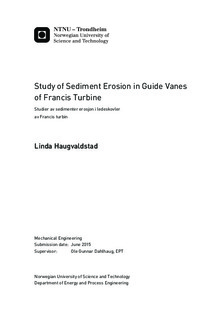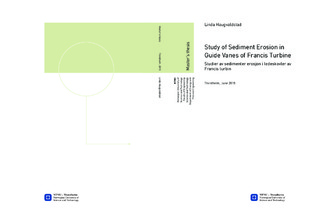| dc.contributor.advisor | Dahlhaug, Ole Gunnar | |
| dc.contributor.author | Haugvaldstad, Linda | |
| dc.date.accessioned | 2015-10-05T14:51:34Z | |
| dc.date.available | 2015-10-05T14:51:34Z | |
| dc.date.created | 2015-06-10 | |
| dc.date.issued | 2015 | |
| dc.identifier | ntnudaim:13761 | |
| dc.identifier.uri | http://hdl.handle.net/11250/2350168 | |
| dc.description.abstract | Sediment erosion wear of Francis turbines is a big problem for power plants near the Himalayas and the Andes Mountains. The turbine components must be maintained often, resulting in reduction of power production and high maintenance cost.
To understand the erosion problem better it is of high interest to study the flow around the guide vanes of a Francis turbine. A test rig which will give the opportunity to study this flow is being designed, and will be used for experimental test at the Turbine Testing Lab at Kathmandu University and it is called 3 GV Cascade.
The test section of the test rig has geometry similar to the guide vane cascade of the Francis turbines at Jhimruk Power Plant in Nepal. A similar test rig 1 GV Cascade is being installed at the Waterpower Laboratory at NTNU the spring of 2015.
The purpose of this thesis has been to describe the test rig and create procedures for everything from following up the production of the rig to successful measurements with a special focus on safety. Particle Image Velocimetry is going to be used for the velocity measurements and to visualize the flow in the cascade. Procedures for leakage- and pressure testing and operation of 3 GV Cascade at TTL are based on procedures at the Waterpower Laboratory. PIV setup, optimization and measurement procedures are based on theory and writer s own experience from doing PIV measurements on the Swirl rig at the Waterpower laboratory. Simple bending stress analyses were performed to make sure that the test rig will be able to withstand a pressure of 10 bar.
Theory about PIV and optimization rules has been given with the intention that it will be helpful when PIV setup and measurements on 3 GV Cascade is going to be performed. Procedures for PIV setup on the Swirl rig have also been included, since it has been planned to use that rig as a PIV training facility at the Waterpower Laboratory. | |
| dc.language | eng | |
| dc.publisher | NTNU | |
| dc.subject | Produktutvikling og produksjon, Strømningsteknikk | |
| dc.title | Study of Sediment Erosion in Guide Vanes of Francis Turbine - Studier av sedimenter erosjon i ledeskovler av Francis turbin | |
| dc.type | Master thesis | |
| dc.source.pagenumber | 84 | |

